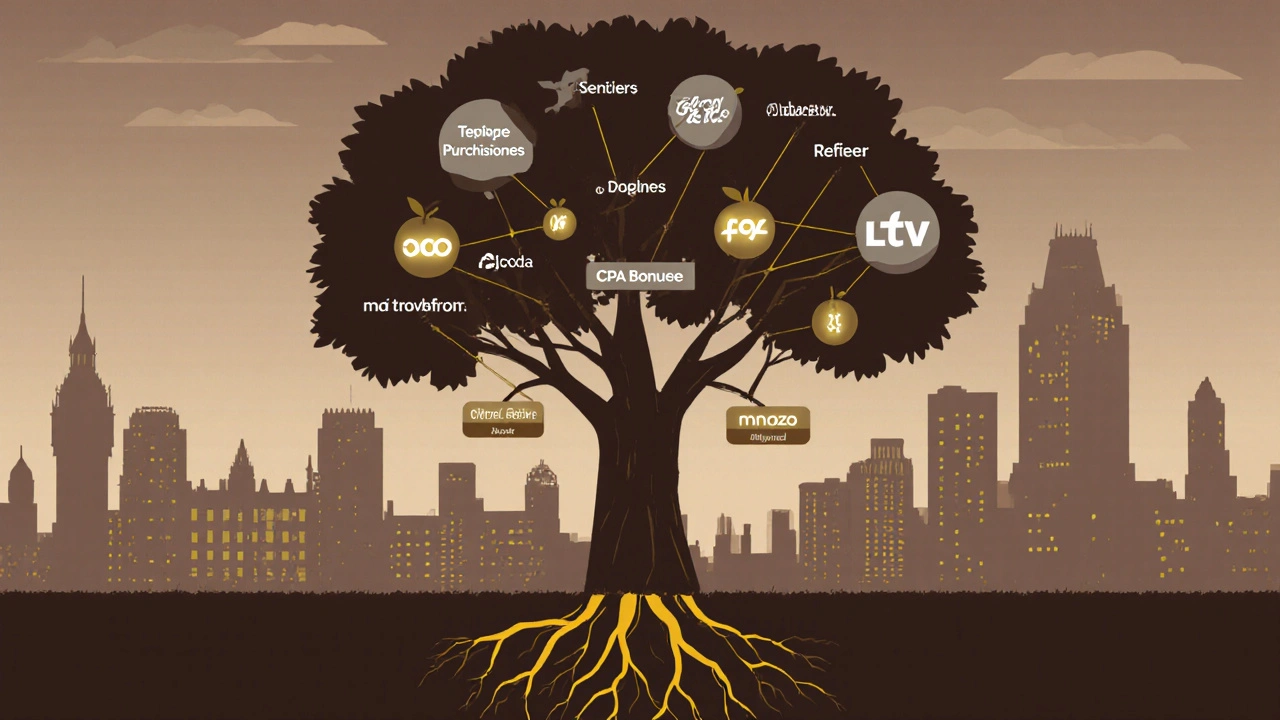Affiliate Partnerships in the UK: Revenue Sharing Models That Work
4 Nov, 2025When you think of affiliate marketing in the UK, you might picture bloggers promoting skincare products or YouTubers linking to Amazon gadgets. But the real money isn’t in those small-scale deals anymore. The most profitable affiliate partnerships in the UK today are built on structured, transparent revenue sharing models that align incentives between brands and publishers. If you’re running a brand or managing an affiliate program, knowing which models actually move the needle is the difference between breaking even and scaling profitably.
How UK Affiliate Partnerships Have Changed
Five years ago, most UK affiliate programs paid a flat 5% to 10% commission per sale. That worked when online shopping was still growing fast and customer acquisition costs were low. But now? The market is saturated. Big retailers like ASOS, John Lewis, and Ocado have cut commissions or switched to performance-based tiers. Meanwhile, smaller brands are learning that paying for clicks or impressions doesn’t drive loyalty-it just burns cash.
The winners today use revenue sharing models that reward long-term value, not just one-time sales. That means shifting from simple percentage commissions to models that track customer lifetime value (LTV), repeat purchases, and even referral quality. It’s not just about who clicks the link-it’s about who stays.
Model 1: Tiered Commission Structures
Tiered commissions are the most common model that works in the UK right now. Instead of paying the same rate to everyone, you reward top performers with higher payouts. For example:
- First 10 sales per month: 8% commission
- 11-50 sales: 12% commission
- 51+ sales: 15% commission + bonus payout
This isn’t just a carrot-it’s a filter. It pushes affiliates to focus on quality content, not spammy links. A study by the Affiliate Marketing Institute in 2024 found that UK programs using tiered structures saw a 42% increase in affiliate retention compared to flat-rate programs.
Brands like The Hut Group and LookFantastic use this model successfully. They track not just sales, but also how many of those customers return within 90 days. If an affiliate drives repeat buyers, they get bumped up a tier automatically. No manual approval needed.
Model 2: Revenue Share with Recurring Commissions
If your product is subscription-based-think meal kits, software, gym memberships, or streaming services-recurring revenue sharing is the gold standard. Instead of paying once, you pay a percentage of every monthly payment the customer makes.
For example:
- Customer signs up via your affiliate link for a £25/month yoga app
- You earn 20% of that £25 every month as long as they stay subscribed
- After 12 months, that affiliate has earned £60 from one sign-up
This model is dominant in SaaS and digital services. Companies like Notion, Canva, and even UK-based fitness platforms like Centr use it. Affiliates who promote these services don’t just make a quick buck-they build passive income streams. That means they’re more likely to write detailed reviews, create comparison guides, and stick around for years.
One UK-based affiliate marketer in Leeds told me he earns more from his 32 recurring subscriptions than he did from 200 one-time sales last year. That’s the power of recurring revenue sharing.
Model 3: CPA Plus Bonus Bonuses
Cost-per-acquisition (CPA) is simple: pay a fixed amount for each new customer. But in the UK, the smartest brands layer in bonuses on top of that.
Here’s how it works:
- Base CPA: £30 per new customer
- Bonus £15 if the customer makes a second purchase within 30 days
- Another £20 if they refer a friend who also signs up
This model encourages affiliates to focus on customer quality, not just quantity. It also reduces fraud. If someone signs up just to collect the £30 and then disappears, the brand doesn’t pay extra. But if the customer sticks around or brings others, the affiliate gets rewarded.
Companies like Revolut and Monzo use this model. Their affiliate dashboards show real-time data: how many customers stayed active, how many referred others. Affiliates can see exactly what drives bonus payouts-and adjust their content accordingly.

Model 4: Hybrid Models with Performance Caps
Not every brand can afford to pay 20% of revenue forever. That’s where hybrid models come in. You combine a base commission with a cap on total payouts per affiliate.
Example:
- 10% commission on all sales
- Maximum £5,000 in commissions per affiliate per year
- After hitting the cap, they still get promoted on your site but earn no more cash
This keeps your costs predictable while still giving top performers big rewards. It’s popular with mid-sized UK retailers who can’t compete with Amazon’s budgets but still want to attract serious publishers.
Brands like The Body Shop and Lush use this. They’ve found that affiliates who hit the cap often become brand ambassadors-writing blogs, hosting live Q&As, even appearing in marketing videos. The cap isn’t a punishment; it’s a gateway to deeper partnership.
What Doesn’t Work Anymore
Three models are fading fast in the UK market:
- Flat-rate commissions without performance tiers-affiliates treat them as disposable income, not a partnership.
- Pay-per-click-too easy to game, and most clicks don’t convert.
- One-time payouts for subscriptions-you’re leaving money on the table if customers stick around.
Also avoid vague terms like “competitive commission.” Affiliates need clear numbers. If you say “we pay top rates,” but don’t say what those rates are, you’ll lose trust fast.
How to Set Up a Winning Program
Starting an affiliate program in the UK isn’t about picking a model-it’s about matching the model to your product and customer behavior.
Ask yourself:
- Do customers buy once or come back monthly?
- Do they refer friends? (If yes, add referral bonuses.)
- Can you track customer LTV? (If not, start with CPA + bonuses.)
- Do you have the tech to automate tier upgrades? (If not, start simple.)
Use platforms like Impact, Awin, or Rakuten Advertising-they handle tracking, payouts, and reporting. Most UK brands use one of these. Don’t try to build your own unless you have a dedicated tech team.
Also, pay on time. UK affiliates expect monthly payments by the 15th. Late payments kill trust faster than low commissions.

Real Example: A UK Skincare Brand That Doubled Revenue
A small London-based brand, Glow & Co., had been paying 8% flat commission. Their affiliate program was quiet. In early 2024, they switched to a hybrid model:
- 12% commission on first purchase
- 5% on all repeat purchases within 12 months
- £25 bonus if the customer referred a friend who bought
- Cap at £4,000 per affiliate per year
Within six months:
- Affiliate sign-ups increased by 70%
- Customer retention from affiliate traffic jumped from 22% to 48%
- Total revenue from affiliates doubled
They didn’t spend more money-they just paid smarter.
Final Tip: Track the Right Metrics
Don’t just track sales. Track:
- Customer retention rate from affiliate traffic
- Repeat purchase rate
- Referral rate from affiliate-driven customers
- Cost per acquired customer vs. cost per acquired customer from paid ads
If your affiliate customers have a higher LTV than your paid ad customers, you’re doing it right. If not, your model needs tweaking.
What’s the average commission rate for UK affiliate programs?
There’s no single average, but most UK programs pay between 5% and 15% of sale value. Subscription services often pay 20% or more of monthly fees. Top-performing brands like Monzo and Notion offer recurring commissions that can total hundreds of pounds per customer over time. Flat-rate programs under 5% rarely attract serious publishers anymore.
Can I run an affiliate program without a big budget?
Absolutely. Many small UK brands start with CPA bonuses-pay £20-£40 per verified customer, with extra for referrals or repeat purchases. You don’t need to pay 15% of revenue to succeed. Focus on quality over quantity. One well-placed blog review from a trusted UK lifestyle site can bring in more sales than 50 low-effort social posts.
Do UK consumers trust affiliate links?
Yes-if the content feels honest. A 2024 YouGov survey found that 68% of UK shoppers trust affiliate recommendations from bloggers or YouTubers they’ve followed for over a year. The key is transparency. Always require affiliates to disclose partnerships. Brands that enforce this see higher conversion rates because trust builds loyalty.
Which platforms are best for UK affiliate programs?
Awin and Impact are the most popular in the UK for their strong publisher networks and reliable tracking. Rakuten Advertising works well for larger brands with international reach. For smaller businesses, ShareASale and CJ Affiliate offer solid tools at lower price points. Avoid niche platforms with limited UK publisher presence-they’ll slow your growth.
How long does it take to see results from an affiliate program?
Most brands see initial sales within 30-60 days, but real growth takes 6-9 months. Affiliates need time to create content, build trust with their audience, and see what converts. Don’t expect overnight results. Focus on long-term relationships. The best UK affiliate programs are built over years, not months.
Next Steps
If you’re a brand: audit your current affiliate program. Are you paying for clicks, or for customers who stay? Switch to a model that rewards retention. Start with one change-maybe add a bonus for repeat purchases-and track the results.
If you’re an affiliate: look for programs with recurring commissions or CPA bonuses. Avoid those that pay flat rates below 7%. Ask for their top-performing content examples. Learn what converts for them.
The UK affiliate market isn’t dying-it’s maturing. The winners aren’t the ones who shout the loudest. They’re the ones who pay fairly, track wisely, and build real relationships.
